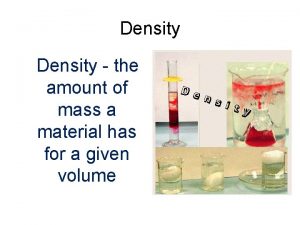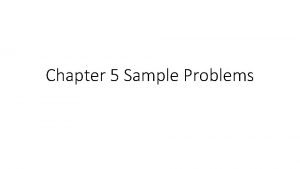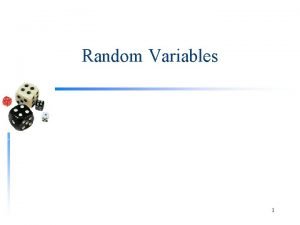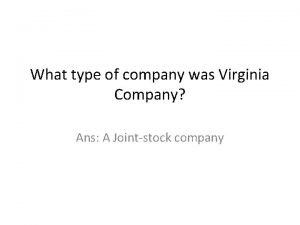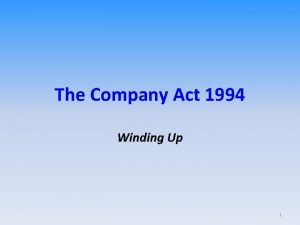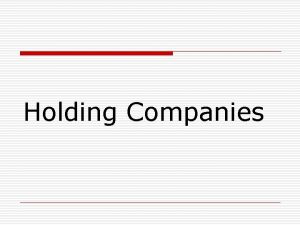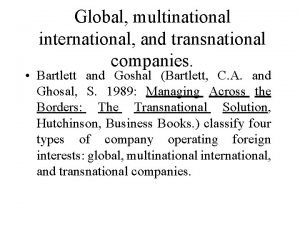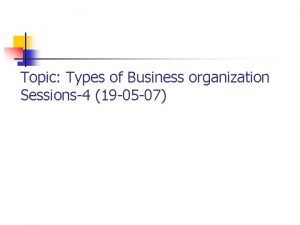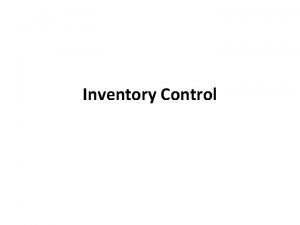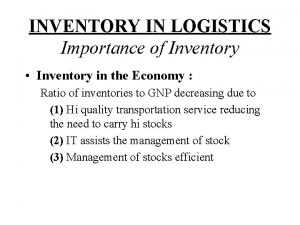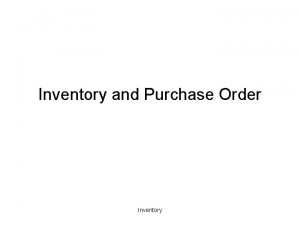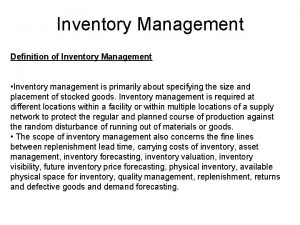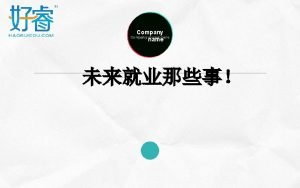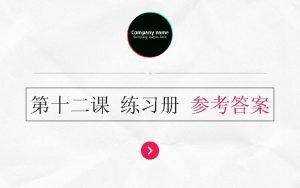Inventory n The amount of material a company


















- Slides: 18

Inventory

n The amount of material, a company has in stock at a specific time is known as inventory or in terms of money it can be defined as the total capital investment over all the materials stocked in the company at any specific time.

Inventory may be in the form of,

Why Inventories? n n Inventories are needed because demand supply can not be matched for physical and economical reasons. There are several other reasons for carrying inventories in any organization. To safe guard against the uncertainties in price fluctuations, supply conditions, demand conditions, lead times, transport contingencies etc.

n n n To reduce machine idle times by providing enough in-process inventories at appropriate locations. To take advantages of quantity discounts, economy of scale in transportation etc. To reduce the material handling cost of semi-finished products by moving them in large quantities between operations.

n To reduce clerical cost associated with order preparation, order procurement etc.

Relevant Inventory Costs Unit cost: : it is usually the purchase price of the item under consideration. If unit cost is related with the purchase quantity, it is called as discount price. Procurement costs: This includes the cost of order preparation, tender placement, cost of postages, telephone costs, receiving costs, set up cost etc. Carrying costs: This represents the cost of maintaining inventories in the plant. It includes the cost of insurance, security, warehouse rent, taxes, interest on capital engaged, spoilage, breakage etc. Stock out costs This represents the cost of loss of demand due to shortage in supplies. This includes cost of loss of profit, loss of customer, loss of goodwill, penalty etc.

Three Mathematical Models for Determining Order Quantity n Economic Order Quantity (EOQ or Q System) n n Economic Production Quantity (EPQ) n n An optimizing method used for determining order quantity and reorder points A model that allows for incremental product delivery Quantity Discount Model n Modifies the EOQ process to consider cases where quantity discounts are available

Economic Order Quantity n EOQ Assumptions: n n n Demand is known & constant no safety stock is required No quantity discounts are available Ordering (or setup) costs are constant All demand is satisfied (no shortages) The order quantity arrives in a single shipment

EOQ: Total Cost Equation

EOQ Total Costs Total annual costs = annual ordering costs + annual holding costs

The EOQ Formula Minimize the TC by ordering the EOQ:

When to Order: The Reorder Point n Without safety stock: n With safety stock:

EOQ Example n n n Weekly demand = 240 units No. of weeks per year = 52 Ordering cost = $50 Unit cost = $15 Annual carrying charge = 20% Lead time = 2 weeks

EOQ Example Solution

ABC Inventory Classification n n ABC classification is a method for determining level of control and frequency of review of inventory items A Pareto analysis can be done to segment items into value categories depending on annual dollar volume A Items – typically 20% of the items accounting for 80% of the inventory value-use Q system B Items – typically an additional 30% of the items accounting for 15% of the inventory value-use Q or P C Items – Typically the remaining 50% of the items accounting for only 5% of the inventory value-use P

ABC Example: the table below shows a solution to an ABC analysis. The information that is required to do the analysis is: Item #, Unit $ Value, and Annual Unit Usage. The analysis requires a calculation of Annual Usage $ and sorting that column from highest to lowest $ value, calculating the cumulative annual $ volume, and grouping into typical ABC classifications.

V. E. D Analysis n n n V- Vital items E- Essential Items D- Desirable Items
 Dmv triangle chemistry
Dmv triangle chemistry Suppose dave's discount merchandise inventory
Suppose dave's discount merchandise inventory As the head of inventory for knowway computer company
As the head of inventory for knowway computer company Material and non material culture examples
Material and non material culture examples Profile tolerance symbol
Profile tolerance symbol Examples of non material culture
Examples of non material culture Standard costing and variance analysis formulas
Standard costing and variance analysis formulas What is a material useful
What is a material useful Example of pop culture
Example of pop culture What type of company was the virginia company
What type of company was the virginia company Winding up of a company in company law
Winding up of a company in company law Holding company and subsidiary company
Holding company and subsidiary company Difference between global company and multinational company
Difference between global company and multinational company Private company vs public company
Private company vs public company điện thế nghỉ
điện thế nghỉ Dot
Dot Nguyên nhân của sự mỏi cơ sinh 8
Nguyên nhân của sự mỏi cơ sinh 8 Trời xanh đây là của chúng ta thể thơ
Trời xanh đây là của chúng ta thể thơ Gấu đi như thế nào
Gấu đi như thế nào
